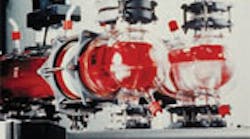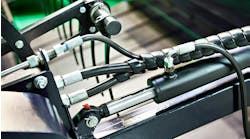Electric motors are the power source of choice for most constant-speed rotary power transmission applications. But when non-routine requirements must be considered, air motors often may be a better choice.
Air motors produce continuous rotary power from compressed air, and they hold many advantages over electric motors. These include:
Tolerant of harsh environments — Dirt and dust can shorten the life of an electric motor. Internal pressure that is higher than ambient helps prevent contaminants from entering an air motor, resulting in longer life in dusty environments. Plastic and stainless steel versions also operate safely under wet and corrosive conditions, and even submerged.
High ambient temperature capability — High temperatures limit the performance of electric motors. An air motor, however, is self-cooling because air traveling through the motor absorbs and carries away large amounts of heat. Air motors generally perform well in ambient temperatures to 300° F, and some are rated for even higher temperatures.
Safe operation — Because they do not require electrical power and have no sparking hazards, air motors can be used in volatile atmospheres. Explosion-proof electric motors, on the other hand, require costly special housings.
Overload protection — Overloads that exceed stall torque typically cause no harm to air motors. With electric motors, overloads can trip circuit breakers that must be reset before restarting equipment. Likewise, stalling can severely damage an electric motor. Because air motors are self-cooling, they can typically be stalled indefinitely without damage. Thus, they are a better choice if the motor is subject to variable loads and the possibility of stalling.
Reversible operation — Many air motors are reversible. Because air is compressible, reversal causes little strain on the motor or shock to equipment or load — and is accomplished in a few degrees of rotation. Electric motors, in contrast, generate large amounts of heat when reversed while running. Special cooling provisions can make electric motors reversible without damage, but such modifications can be expensive.
Compact size — Air motors generally have a higher power density, developing more horsepower per pound and cubic inch than do most standard electric motors. So a smaller air motor can deliver the same power as its electric counterpart. A typical rotary vane air motor, for instance, can weigh half to one-third that of a comparable electric motor.
Simple control — Unlike electric motors, many air motors can operate without the need for auxiliary speed reducers. Air motor speed can be regulated through simple flow control valves instead of expensive and complicated electronic speed controls. And air motor torque can be varied simply by regulating pressure. Although air motors operated directly from a plant air system are susceptible to speed and torque variations if system pressure and flow fluctuate, some manufacturers offer controllers that can, for hold motor speed constant under variable load. Such controls are ideal for liquid-stirring applications where torque changes as liquid level or viscosity varies.
Air motor designs include turbine, V-type, and diaphragm, but rotary vane, axial piston, and radial piston air motors are most commonly used for industrial applications. Following is a look at product offerings from key suppliers.
Vane and piston motorsSmall and large motors
An extensive line of pneumatic motors fits applications from small handheld devices to large stationary machinery. Power output ranges from 0.1 to 6.5 kW (0.1 to 8.3 hp). Lubrication-free motors are standard in sizes up to 300 W. Motors with brake modules are for use when the output shaft must not rotate after air shut-off. Stainlesssteel versions withstand corrosive environments in food and chemical industries.
Atlas Copco, (248) 373-3000, www.atlascopco-airmotors.com
200+ motors
More than 200 models of air motors provide efficient alternatives to electric motors. Options include vane or piston configurations, reversible and non-reversible types, and geared and non-geared varieties. Power ratings range from 0.10 to 30 hp, speeds from 23 to 26,000 rpm, and torques range from 0.10 to 1090 ft-lb. Coolrunning characteristics mean they will not overheat or burn out in ambient temperatures to 300°F.
Ingersoll Rand Industrial Technologies, (704) 896-4000, www.ingersollrandproducts.com
Air motors save power
A recently redesigned series of air motors uses an integral rotary valve to supply compressed air to each of three pistons that quietly transmit high torque at variable low speeds. The motor consumes up to 80% less air than a vane motor, providing significant cost savings even at maximum torque. It reportedly excels in constant start-stop applications under load that can cause electric motors to burn out and vane motors to stall. Three basic sizes come in aluminum, stainless steel for harsh environments, or plastic for high-pressure washdown environments. Maximum torques are to 16 Nm, or 550Nm with a gearbox.
Huco Dynatork, Altra Industrial Motion, +44 1992 501900, www.huco.com
Heavy duty units
Globe radial-piston air motors are available with a wide range of control valve and output options. They have four or five pistons with oil bath lubrication and are said to develop more power than other motors of equivalent size. The motors deliver 2.4 to 32 hp, are suited for intermittent or continuous operation, and operate in temperatures from ± 4 to 176°F. Applications include winches, conveyors, hoists, mixers, and pumps.
SPX Stone Hydraulic Systems, (815) 874-5556 (866) 729-4104, www.globeairmotors.com
For a listing of air motors, key specifications, and manufacturers, click here.
Contact Information:
Atlas Copco Tools & Assembly Systems, 2998 Dutton Rd., Auburn Hills, Mich. 48326; (248) 373-3000; www.atlascopco-airmotors.com
Apex Tool Group LLC, 14600 York Rd. Suite A, Sparks, Md 21152 www.apexpowertools.comGast Mfg. Corp., Benton Harbor, Mich. 49023-0097; (616) 926-6171; www.gastmfg.com
Huco Dynatork, Altra Industrial Motion, Merchant Dr., Hertford, Hertfordshire SG13 7BL, England; +44 1992 501900; www.huco.com
Ingersoll Rand, Industrial Technologies, 800-D Beaty St., Davidson, N.C 28036; (704) 896-4000; www.ingersollrandproducts.com
Micro Motors, Inc., 151 E. Columbine Ave., Santa Ana, Calif. 92707; (714) 546-4045; (800) 562-6204; www.micromotorsinc.com
Parker Hannifin Corp., Pneumatic Div., 8676 East M-89, Richland, Mich. 49083; (269) 629-5000; www.parker.com/pneumatics
SPX Stone Hydraulic Systems, 5885 11th St., Rockford Ill., 61109- 3699; (815) 874-5556 (866) 729-4104; stonehydraulics.com
Suhner Manufacturing, P.O. Box 1234, Rome, Ga. 30162; (706) 235- 5593; www.suhner.com
Taiyo America, Inc., 1120 N. DuPage Ave., Lombard Ill., 60147; (630) 691-8811; (800) 544-8775; www.airpro-taiyo.com
Tonson Inc., 105 Dearborn Dr., Dothan, Ala., 36305; (334) 702 8451; (800) 318 3233; www.tonsoninc.com










